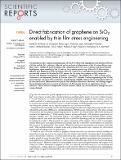| dc.contributor.author | McNerny, Daniel Q. | |
| dc.contributor.author | Viswanath, B. | |
| dc.contributor.author | Copic, Davor | |
| dc.contributor.author | Laye, Fabrice R. | |
| dc.contributor.author | Brieland-Shoultz, Anna C. | |
| dc.contributor.author | Polsen, Erik S. | |
| dc.contributor.author | Veerasamy, Vijayen S. | |
| dc.contributor.author | Prohoda, Christophor George | |
| dc.contributor.author | Dee, Nicholas Thomas | |
| dc.contributor.author | Hart, Anastasios John | |
| dc.date.accessioned | 2014-07-08T19:28:52Z | |
| dc.date.available | 2014-07-08T19:28:52Z | |
| dc.date.issued | 2014-05 | |
| dc.date.submitted | 2014-03 | |
| dc.identifier.issn | 2045-2322 | |
| dc.identifier.uri | http://hdl.handle.net/1721.1/88210 | |
| dc.description.abstract | We demonstrate direct production of graphene on SiO[subscript 2] by CVD growth of graphene at the interface between a Ni film and the SiO[subscript 2] substrate, followed by dry mechanical delamination of the Ni using adhesive tape. This result is enabled by understanding of the competition between stress evolution and microstructure development upon annealing of the Ni prior to the graphene growth step. When the Ni film remains adherent after graphene growth, the balance between residual stress and adhesion governs the ability to mechanically remove the Ni after the CVD process. In this study the graphene on SiO[subscript 2] comprises micron-scale domains, ranging from monolayer to multilayer. The graphene has >90% coverage across centimeter-scale dimensions, limited by the size of our CVD chamber. Further engineering of the Ni film microstructure and stress state could enable manufacturing of highly uniform interfacial graphene followed by clean mechanical delamination over practically indefinite dimensions. Moreover, our findings suggest that preferential adhesion can enable production of 2-D materials directly on application-relevant substrates. This is attractive compared to transfer methods, which can cause mechanical damage and leave residues behind. | en_US |
| dc.description.sponsorship | Guardian Industries | en_US |
| dc.description.sponsorship | National Science Foundation (U.S.). Graduate Research Fellowship Program | en_US |
| dc.language.iso | en_US | |
| dc.publisher | Nature Publishing Group | en_US |
| dc.relation.isversionof | http://dx.doi.org/10.1038/srep05049 | en_US |
| dc.rights | Creative Commons Attribution-NonCommercial-ShareAlike 3.0 | en_US |
| dc.rights.uri | http://creativecommons.org/licenses/by-nc-sa/3.0/ | en_US |
| dc.source | Nature Publishing Group | en_US |
| dc.title | Direct fabrication of graphene on SiO[subscript 2] enabled by thin film stress engineering | en_US |
| dc.type | Article | en_US |
| dc.identifier.citation | McNerny, Daniel Q., B. Viswanath, Davor Copic, Fabrice R. Laye, Christophor Prohoda, Anna C. Brieland-Shoultz, Erik S. Polsen, Nicholas T. Dee, Vijayen S. Veerasamy, and A. John Hart. “Direct Fabrication of Graphene on SiO2 Enabled by Thin Film Stress Engineering.” Sci. Rep. 4 (May 23, 2014). | en_US |
| dc.contributor.department | Massachusetts Institute of Technology. Department of Mechanical Engineering | en_US |
| dc.contributor.mitauthor | Viswanath, B. | en_US |
| dc.contributor.mitauthor | Prohoda, Christophor George | en_US |
| dc.contributor.mitauthor | Dee, Nicholas Thomas | en_US |
| dc.contributor.mitauthor | Hart, Anastasios John | en_US |
| dc.relation.journal | Scientific Reports | en_US |
| dc.eprint.version | Final published version | en_US |
| dc.type.uri | http://purl.org/eprint/type/JournalArticle | en_US |
| eprint.status | http://purl.org/eprint/status/PeerReviewed | en_US |
| dspace.orderedauthors | McNerny, Daniel Q.; Viswanath, B.; Copic, Davor; Laye, Fabrice R.; Prohoda, Christophor; Brieland-Shoultz, Anna C.; Polsen, Erik S.; Dee, Nicholas T.; Veerasamy, Vijayen S.; Hart, A. John | en_US |
| dc.identifier.orcid | https://orcid.org/0000-0002-1532-2083 | |
| dc.identifier.orcid | https://orcid.org/0000-0002-8633-3564 | |
| dc.identifier.orcid | https://orcid.org/0000-0002-7372-3512 | |
| mit.license | PUBLISHER_CC | en_US |
| mit.metadata.status | Complete | |
